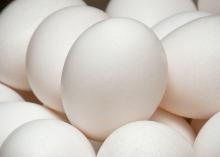Information Possibly Outdated
The information presented on this page was originally released on May 7, 2010. It may not be outdated, but please search our site for more current information. If you plan to quote or reference this information in a publication, please check with the Extension specialist or author before proceeding.
State's poultry industry on upswing to recovery
By Patti Drapala
MSU Ag Communications
MISSISSIPPI STATE – Mississippi’s poultry industry is cautiously optimistic that the economic doldrums of the last two years -- brought on by the high costs of energy, feed and debt -- may finally be over.
Insider talk of expansion, new export markets and domestic consumption of eggs and breast meat may be indicators the upswing has begun.
“We’re gearing up for 2010,” said Mark Leggett, president of the Mississippi Poultry Association. “Both 2008 and 2009 were rough times for the industry. People are telling me they think they are doing better and are ready to roll.”
Although poultry has been the state’s No. 1 agricultural commodity in terms of economic value for more than a decade, the people who make up the industry have struggled. In 2008, gasoline and diesel prices hit $4 per mark, increasing transportation costs. Consumers cut back on dining out because of expensive gasoline prices, and many restaurants went under when customer numbers dropped.
That same year, corn prices hit $8 a bushel, which caused feed prices to increase.
“Corn is the bulk ingredient in chicken feed, and feed is the bulk of production costs,” Leggett said.
Rising energy costs in 2008 did not help the industry either.
“One of the biggest expenses in the poultry industry is electricity, propane and other energy,” said Danny Thornton, Extension poultry specialist in Mississippi State University’s Department of Poultry Science. “Eons ago, electricity was relatively cheap at 4 to 5 cents a kilowatt, and the cost today is significantly greater.”
Then, in 2009, industry participants spent considerable time and money repaying debt that accrued from the high production costs of the previous year.
“The poultry industry is cyclical,” Leggett said “When times are good, the tendency is to produce more quantities, and prices start going down because of increased supply. Companies scale back production and when demand goes back up, they have to gear up production again.”
One of the reasons the state’s poultry industry can recover from setbacks is the close attention paid to consumer demand. The industry is a leader in identifying what consumers want, and it uses infrastructure and MSU’s research results to adapt to market changes.
“If demand for a product goes up, the industry will produce it because it is so diversified and has its finger on the pulse of the consumer,” Thornton said.
The poultry industry also has its eye on new markets because of world trade issues from two of its biggest export markets, Russia and China.
Russia is the No. 1 market for U.S. poultry, particularly leg quarters. Its government is considering strengthening domestic production to become less reliant on poultry imports, which caused sales of U.S. poultry to decline.
China is America’s second largest export market, which includes high demand for chicken feet, or paws. China imposed two sets of tariffs on U.S. poultry because of a trade disagreement, and U.S. poultry sales there fell.
“Our industry is looking at other world markets, so exports will probably recover,” Thornton sad. “Market development is a slow process, and it takes time to establish a relationship between the seller and the buyer. And the situations in Russia and China may resolve themselves, too.”
Increasing domestic demand for chicken wings also will help the market outlook for poultry. Consumer purchases of breast meat and eggs is holding steady, which supports prices, too.
“Mississippi’s poultry industry is greatly enhanced by table egg production, particularly from the nation’s largest supplier, Cal-Maine Foods, which is headquartered in Jackson,” Leggett said.
With May being National Egg Month, many egg companies will be launching new advertising campaigns to increase consumption.
“At an average of $1.25 per dozen, eggs are a good buy and are a rich source of protein,” Thornton said. “Eggs are one of the more profitable segments of the poultry industry. When everything else in the economy gets bad, the egg market gets better.”






